Top>Research>Joint industry-academia development of Seismic Retrofit of Asphalt Pavement using Confined Reinforced Earth
 Index
Index
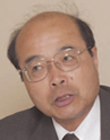
Hideki Ohta [Profile]
Education Course
Joint industry-academia development of Seismic Retrofit of Asphalt Pavement using Confined Reinforced Earth
Hideki Ohta
Professor of Civil Engineering, Geotechnical Engineering and Geotechnical Construction Engineering, Research and Development Initiatives, Chuo University
1.Overview of the developed concept
Let me introduce a newly developed concept of Seismic Retrofit of Asphalt Pavement using Confined Reinforced Earth. This was developed through joint industry-academia research with Maeda Kosen Co., Ltd. and NIPPO conducted at the Research Unit for Geotechnical Engineering in Practice (Director: Professor Kunio Saito) of the Center for Research and Development Initiatives, Chuo University.
This joint research resulted in the development of new method for inhibiting unevenness as an anti-earthquake measure for asphalt pavement. The method involves anti-earthquake reinforcement technology and can be applied not only to newly constructed roads but also to roads which are currently in service. In recent years, large-scale earthquakes in Japan have resulted in unevenness in the pavement of roads open to public and private roads inside the factory premises. In many cases, this unevenness made it impossible for emergency vehicles to use the roads. The minimum functionality of roads for vehicle access, even at low speed, is essential for initial emergency response such as lifesaving and firefighting activities, as well as for emergency restoration of plant functionality and other aspects of corporate business continuity plans (BCP). The newly developed technology to suppress unevenness is anti-earthquake reinforcement technology to ensure minimum functionality of roads.
The origin of this anti-earthquake reinforcement technology lies in the following question: Can reinforced earth methods which utilize grid reinforcement materials (geogrids) and have been used in conventional embankments be effectively applied to road pavement? The method constructs a composite rigid layer in the subgrade which supports the pavement. This layer is composed of granular materials, geogrids and confining members. Put simply, a geogrid is effectively used to reinforce the aggregate layer which lies beneath asphalt pavement. This prevents sudden unevenness from occurring even if the embankments settle during earthquakes. The mechanical key point is the mechanism of producing drastic increase in the shear resistance of the granular materials by introducing confining effect on the granular materials via confining members.
2.Results of full-scale experiments
A pair of full-scale experiments for this anti-earthquake reinforcement technology was held last year. In the experiments, a full-scale subgrade and roadbed were created. The roadbed was then coated with two types of asphalt pavement. The first type was conventional pavement, while the second was pavement using this anti-earthquake reinforcement technology. We aimed at direct comparison of performance of the two pavement types by artificially creating the differential settlement of road embankment which is often seen during major earthquakes. The differential settlement of the embankment was realized using a set of large hydraulic jacks.
Experimental results showed that use of the new anti-earthquake reinforcement technology maintains minimum road usability for vehicles even when the differential settlement reaches approximately 600 millimeters. Although the asphalt pavement settles together with the embankment, there is no splitting of pavement or creation of unevenness. Instead, the pavement settled in a gentle curve as shown in Photograph 1. The curve is smooth enough for vehicles to drive at low speeds. Conversely, in the case of conventional pavement, the asphalt pavement splits and unevenness occurs during settlement of approximately 200 millimeters. It is absolutely impossible for vehicles to drive in such conditions. Photograph 2 shows the difference between the 2 pavement types. I believe that this anti-earthquake reinforcement technology can contribute to the construction of safer and more stable roads, and can be used as anti-earthquake measure to prepare roads for damage from major earthquakes, as well as a measure against differntial settlement of road embankments placed on soft ground.
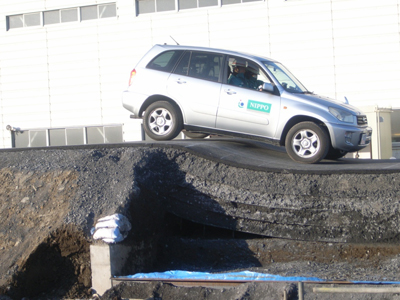
Photograph 1: Smooth settlement curve which occurs through this anti-earthquake reinforcement technology
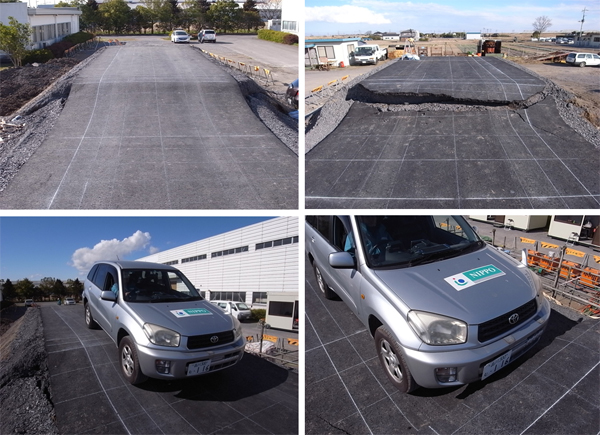
Photograph 2: Results from full-scale experiment for this anti-earthquake reinforcement technology (The two photographs on the left show pavement using this anti-earthquake reinforcement technology. Note that vehicles can be driven. In contrast, vehicles cannot be driven on the conventional pavement shown in the two photographs on the right.)
3.Long-term joint research
Since long ago, there has been a movement to encourage joint research between corporations and universities. When I was working for Kanzawa University, regional universities were presumably suggested by the MEXT (Ministry of Education, Culture, Sports, Science and Technology) to actively conduct research with local corporations. I was directed to come up with ideas for such joint research. I decided to consult with Professor Katsuhiko Arai of Fukui University. Our discussion led to joint research for reinforced earth using geotextiles being conducted by Maeda Kosen Co., Ltd. and Fukui University from Fukui Prefecture and Magara Construction Co., Ltd. and Kanazawa University from Ishikawa Prefecture. This joint research continued for a long time and produced appreciable harvests. The first theme addressed by the research was an attempt to create a bridge from earth as shown in Photograph 3. As you see, the project failed to proceed smoothly, but a wide variety of ideas were born as consequence of our trial that was not fully successful. One of the successes resulting from such ideas is an anti-earthquake reinforcement technology for asphalt pavement, the subject of this article.
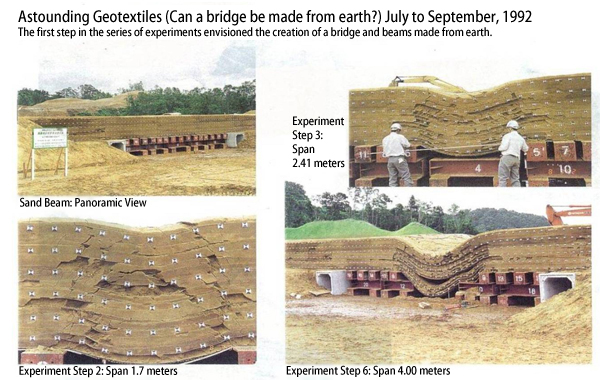
Photograph 3: Our experiment to make a bridge from earth was not fully successful
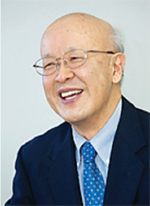
Photograph 4: Mr. Yukitoshi Maeda
Since the beginning of this joint research and continuing until today, I have had the privilege of working with President Yukitoshi Maeda of Maeda Kosen. President Maeda graduated from the Osaka University, School of Engineering Science in 1968. He founded Maeda Kosen in 1972 and has since focused on expanding the company's business. Thanks to his efforts, the company has grown to the point where it is now listed on the Tokyo Stock Exchange. President Maeda transformed a traditional weaving factory in Fukui Prefecture into a modern manufacturer of geosynthetics. He is active in many fields, including serving as Chairperson of the Fukui Association of Corporate Executives and a member of the executive board at Fukui University.
At the time that Photograph 3 was taken, Mr. Toshiharu Nishimoto was employed as Vice-Director of the Technical Research Institute at Magara Construction. Mr. Nishimoto supervised the experiment shown in the photograph. Afterwards, Mr. Nishimoto joined Maeda Kosen where he now serves as a head manager.
During his 4th year at Kanazawa University, Dr. Tsutomu Ishigaki was involved in the onsite experiment shown in Photograph 3 as his graduation project. At the time of the experiment, he received an employment offer from NIPPO. He entered NIPPO and now serves as a core member of the Technical Research Institute.
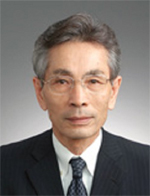
Photograph 5: President Kazunori Mizushima
For a long period of time, these members worked together in order to conduct joint research with Maeda Kosen and NIPPO. New members also joined the project. Mr. Kazunori Mizushima succeeded Mr. Kikuo Hayashida to become President of NIPPO. President Mizushima graduated from the Department of Civil Engineering at the Faculty of Science and Engineering, Chuo University in 1968. He is prominent Chuo University alumni within the industry. I have read some of President Mizushima's writings, and he is actually a free and witty individual who doesn't seem to come from a science and engineering background.
4.Valuable advice and subsequent results
Around 1998, I had a challenging project of creating two high embankments with a height of 40 meters and a gradient of 1:1 in Toga Village, Toyama Prefecture. This project came to me just after the aforementioned joint research (Maeda Kosen, Fukui University, Magara Construction, Kanzawa University) in reinforced earth using geotextiles had settled down a bit. It was extremely difficult to fulfill requests from the village government, which included planting trees instead of grass on the slope and creating an embankment which was not affected by heavy snow. I lacked confidence and sought help from staff at Maeda Kosen, as well as from three prominent experts in the field of reinforced earth: Professor Fumio Tatsuoka of the University of Tokyo, Dr. Osamu Murata of the Railway Technical Research Institute, and Dr. Hiroshi Miki of the Public Works Research Institute.
These three individuals provided me with a great amount of varied advice through their experience and knowledge for reinforced earth. As a result, we could complete the construction of two high embankments as shown in Photograph 6. Both today and at that time, the group containing the University of Tokyo and the Railway Technical Research Institute has been a leader in the field of reinforced earth. I believe that my work was a success thanks to advice from both Professor Tatsuoka and Dr. Murata, who suggested me to implement pre-stresses within the reinforced earth.
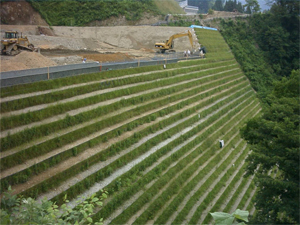
Photograph 6: A high embankment completed in I-no-Tani Valley, Toga Village, Toyama Prefecture
At that time, the idea of implementing pre-stresses in reinforced earth was advanced technology even from a global perspective (for example: Taro Uchimura, Fumio Tatsuoka, Masaru Tateyama, Junichi Koseki, Takashi Maeda, Hideki Tsuru: Mechanisms, Element Tests, Full-Scale Model Tests and Construction of Preloaded and Prestressed Geosynthetic Reinforced Soil Structure, Proc. 11th Geosynthetics Symposium, the Japanese Chapter of the International Geosynthetics Society, 72-18, 1996). The embankment shown in Photograph 6 was completed by employing their advanced technology.
In order to maintain pre-stresses in embankments for a long period of time, high level technology is needed during design and implementation. I therefore searched for a method without too much dependence on pre-stresses. One of my conclusions was the concept of Seismic Retrofit of Asphalt Pavement using Confined Reinforced Earth introduced at the beginning of this article.
The main supervisors of joint research for this new method are Dr. Tsutomu Ishigaki of NIPPO, who conducted the experiment shown in Photograph 3 during his 4th year at Kanazawa University, and Dr. Naoki Tatta of Maeda Kosen. At the start of the research, Dr. Tsutomu Ishigaki was a doctoral student in a Doctoral Program for businesspeople under my supervision at the Tokyo Institute of Technology. Dr. Naoki Tatta was in a Doctoral Program for businesspeople under the supervision of Professor Katsuhiko Arai at Fukui University. The joint research was out of scope of their doctoral research themes. However, Dr. Ishigaki and Dr. Tatta conducted the research in addition to their Ph.D works. We began the research by creating a small indoor model of the confined reinforced earth and by reviewing the mechanical properties of granular material using a large-scale simple shear testing device. Little by little, we continued to perform research until we confirmed the capability through large full-scale experiments of actual pavement which were conducted a total of five times for twelve test fills. Although both Dr. Ishigaki and Dr. Tatta are employed at different companies, they cooperated fully in the joint industry-academia research. Perhaps their spirit of cooperation was born because they are around the same age and in the same circumstances. I was extremely surprised by the dedication of Dr. Ishigaki, who had continued to develop the anti-earthquake reinforcement technology for nearly 20 years to win his current success. Dr. Ishigaki was born in Niigata Prefecture and Dr. Tatta was born in Fukui Prefecture, both prefectures in the Hokuriku Region. Therefore, I would like to conclude this article by expressing my respect for the admirable tenacity and purpose of people from Hokuriku.
- Hideki Ohta
Professor of Civil Engineering, Geotechnical Engineering and Geotechnical Construction Engineering, Research and Development Initiatives, Chuo University - Born in Tokyo in 1944.
1966: Graduated from the Kyoto University, Faculty of Engineering.
1968: Completed the Master's Program at the Graduate School of Engineering, Kyoto University.
1971: Withdrew from the Doctoral Program at the Graduate School of Engineering, Kyoto University. Holds a D. Eng (Kyoto University).
Served as an Assistant, Lecturer and Assistant Professor at the Faculty of Engineering at Kyoto University, an Assistant Professor and Professor at Kanazawa University, and a Professor at the Tokyo Institute of Technology. In 2009, assumed the position of Professor at the Center for Research and Development Initiatives, Chuo University. Former President of the Japanese Geotechnical Society.
His current research themes include civil engineering, geotechnical engineering and geotechnical construction engineering.
- Research Activities as a Member of Research Fellowship for Young Scientists (DC1), Japan Society for the Promotion of Science (JSPS) Shuma Tsurumi
- Important Factors for Innovation in Payment Services Nobuhiko Sugiura
- Beyond the Concepts of Fellow Citizens and Foreigners— To Achieve SDGs Goal 10 “Reduce Inequality Within and Among Countries” Rika Lee
- Diary of Struggles in Cambodia Fumie Fukuoka
- How Can We Measure Learning Ability?
—Analysis of a Competency Self-Assessment Questionnaire— Yu Saito / Yoko Neha - The Making of the Movie Kirakira Megane








